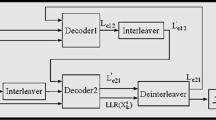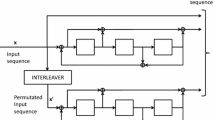Abstract
This paper presents the design of an interleaver for short Parallel Turbo Codes (PTC) with short block lengths in the order of 64, 128, and 256 bits. In particular, the objective is to design an interleaver that generates decorrelation in the external input information to parallel recursive convolutional encoders, with sufficient data propagation to reduce the Bit Error Rate (BER). Experimental tests are designed and implemented −by numerical calculations− using the MatLab/Simulink software. The S-random interleaver, which applies circular displacement and a propagation constraint, is employed. An excellent reduction in BER is achieved for the three short block lengths, according to the quality indicator defined by the International Telecommunication Union (ITU).








Similar content being viewed by others
References
Berrou, C., Glavieux, A., & Thitimajshima, P. (1993). Near Shannon limit error-correcting coding and decoding: Turbo-codes. 1. In: Proceedings of ICC'93-IEEE International Conference on Communications pp. 1064–1070. IEEE. https://doi.org/10.1109/ICC.1993.397441.
E-UTRA (2012) Evolved universal terrestrial radio access (E-UTRA); multiplexing and channel coding, Technical Specifications 36. 212 release-11, Sophia Antipolis Cedex, France.
Arora, K., Singh, J., & Randhawa, Y. S. (2019). A survey on channel coding techniques for 5G wireless networks. Telecommunication Systems. https://doi.org/10.1007/S11235-019-00630-3
Coşkun, M. C., Durisi, G., Jerkovits, T., Liva, G., Ryan, W., Stein, B., & Steiner, F. (2019). Efficient error-correcting codes in the short blocklength regime. Physical Communication, 34, 66–79. https://doi.org/10.1016/J.PHYCOM.2019.03.004
Boccardi, F., Heath, R., Lozano, A., Marzetta, T. L., & Popovski, P. (2014). Five disruptive technology directions for 5G. IEEE Communications Magazine, 52, 74–80. https://doi.org/10.1109/MCOM.2014.6736746
Paolini, E., Stefanović, Č, Liva, G., & Popovski, P. (2015). Coded random access: Applying codes on graphs to design random access protocols. IEEE Communications Magazine, 53, 144–150. https://doi.org/10.1109/MCOM.2015.7120031
Durisi, G., Koch, T., & Popovski, P. (2016). Toward Massive, Ultrareliable, and Low-Latency Wireless Communication with Short Packets. Proceedings of the IEEE, 104, 1711–1726. https://doi.org/10.1109/JPROC.2016.2537298
Sága, M., Bulej, V., Čuboňova, N., Kuric, I., Virgala, I., & Eberth, M. (2020). Case study: Performance analysis and development of robotized screwing application with integrated vision sensing system for automotive industry. International Journal of Advanced Robotic Systems, 17(3), 172988142092399. https://doi.org/10.1177/1729881420923997
Ibrahim, I. N., Pavol, B., Al Akkad, M. A., & Karam, A. (2017, June). Navigation control and stability investigation of a hexacopter equipped with an aerial manipulater. In: 2017 21st International Conference on Process Control (PC) (pp. 204-209). IEEE. doi: https://doi.org/10.1109/PC.2017.7976214.
Oestman, J., Durisi, G., Ström, E. G., Li, J., Sahlin, H., & Liva, G. (2017). Low-latency ultra-reliable 5G communications: Finite-blocklength bounds and coding schemes. In: SCC 2017; 11th International ITG Conference on Systems, Communications and Coding (pp. 1-6). VDE.
Shirvanimoghaddam, M., Mohammadi, M. S., Abbas, R., Minja, A., Yue, C., Matuz, B., Han, G., Lin, Z., Liu, W., Li, Y., Johnson, S., & Vucetic, B. (2019). Short block-length codes for ultra-reliable low latency communications. IEEE Communications Magazine, 57, 130–137. https://doi.org/10.1109/MCOM.2018.1800181
Van Wonterghem, J., Alloum, A., Boutros, J. J., & Moeneclaey, M. On performance and complexity of OSD for short error correcting codes in 5G-NR, 2017. https://www.researchgate.net/publication/316840274 (accessed October 3, 2020).
Salija, P., Yamuna, B., Padmanabhan, T. R., & Mishra, D. (2019). Performance analysis of reliability-based decoding algorithm for short block length turbo codes. IETE Journal of Research. https://doi.org/10.1080/03772063.2019.1670104
Jerkovits, T., & Matuz, B. (2016). Turbo code design for short blocks. In: 2016 8th Advanced satellite multimedia systems conference and the 14th signal processing for space communications workshop (ASMS/SPSC) (pp. 1-6). IEEE. doi: https://doi.org/10.1109/ASMS-SPSC.2016.7601543.
Ferez, L. C., Seghers, J., & Costello, D. J. (1996). A distance spectrum interpretation of turbo codes. IEEE Transactions on Information Theory, 42, 1698–1709. https://doi.org/10.1109/18.556666
Arif, M., Sheikh, N. M., & Sheikh, A. U. H. (2008). Design of two step deterministic interleaver for turbo codes. Computers & Electrical Engineering, 34, 368–377. https://doi.org/10.1016/j.compeleceng.2007.10.009
Tonnellier, T., Leroux, C., Le Gal, B., Gadat, B., Jego, C., & Van Wambeke, N. (2016). Lowering the error floor of turbo codes with CRC verification. IEEE Wirel. Commun. Lett., 5, 404–407. https://doi.org/10.1109/LWC.2016.2571283
Feng, W., Yuan, J., & Vucetic, B. S. (2002). A code-matched interleaver design for turbo codes. IEEE Transactions on Communications, 50, 926–937. https://doi.org/10.1109/TCOMM.2002.1010612
Bohorquez, R. G., Nour, C. A., & Douillard, C. (2018). Protograph-based interleavers for punctured turbo codes. IEEE Transactions on Communications, 66(5), 1833–1844. https://doi.org/10.1109/TCOMM.2017.2783971
Zaitsev, S. V., Kazymyr, V. V., Vasilenko, V. M., & Yarilovets, A. V. (2018). Adaptive selection of parameters of s-random interleaver in wireless data transmission systems with turbo coding. Radioelectronics and Communications Systems, 61, 13–21. https://doi.org/10.3103/S0735272718010028
Martinez, J. E., Crespo, P. M., & Garcia-Frías, J. (2019). On the performance of interleavers for quantum turbo codes. Entropy, 21(7), 633. https://doi.org/10.3390/e21070633
Sreedevi, M., Yamuna, B., & Salija, P. (2019, November). Design and Implementation of Interleaver in GNU Radio for short block length Turbo codes. In: 2019 9th International Conference on Advances in Computing and Communication (ICACC) (pp. 17-21). IEEE. doi: https://doi.org/10.1109/ICACC48162.2019.8986185.
UIT-T (1996) P series: Telephone transmission quality.
Castiñeira Moreira, J., Farrell, PG., Essentials of error-control coding, John Wiley & Sons, 2006. https://books.google.cl/books?id=QmZQ-A76FusC&dq=Moreira+and+P.+G.+Farrell,+Essentials+of+Error-Control+Coding,+Wiley,+2006.&hl=es&source=gbs_navlinks_s (accessed June 5, 2019).
Trifina, L., Tarniceriu, D., Ryu, J., & Rotopanescu, A. M. (2020). Further upper bounds on the minimum distance for turbo codes using CPP interleavers. Physics Communication, 43, 101212. https://doi.org/10.1016/j.phycom.2020.101212
Trifina, L., Tarniceriu, D., Ryu, J., & Rotopanescu, A. M. (2020). Some lengths for which CPP interleavers have weaker minimum distances than QPP interleavers. Journal of the Franklin Institute, 357, 3097–3112. https://doi.org/10.1016/J.JFRANKLIN.2020.02.031
Sahnoune, A., & Berkani, D. (2021). On the performance of chaotic interleaver for turbo codes. SN Applied Science, 3, 1–9. https://doi.org/10.1007/S42452-021-04147-W
Sharma, S., Sau, P. C., & Shukla, A. (2014). Performance analysis of S-Random interleaver for IDMA system using MRRC diversity scheme. In: 2014 Seventh International Conference on Contemporary Computing (IC3) (pp. 248-253). IEEE. doi: https://doi.org/10.1109/IC3.2014.6897181.
Divsalar, D., & Pollara, E. (1995). Low-rate turbo codes for deep-space communications. In: Proceedings of 1995 IEEE International Symposium on Information Theory (p. 35). IEEE. doi: https://doi.org/10.1109/isit.1995.531137.
Hu, X. Y., Eleftheriou, E., & Arnold, D. M. (2005). Regular and irregular progressive edge-growth tanner graphs. IEEE Transactions on Information Theory, 51, 386–398. https://doi.org/10.1109/TIT.2004.839541
Barnault, L., & Declercq, D. (2003, March). Fast decoding algorithm for LDPC over GF (2/sup q/). In Proceedings 2003 IEEE Information Theory Workshop (Cat. No. 03EX674) (pp. 70-73). IEEE. doi: https://doi.org/10.1109/ITW.2003.1216697.
Acknowledgements
This work was supported by the Vicerrectoría de Investigación, Desarrollo e Innovación of the University of Santiago of Chile, Chile.
Author information
Authors and Affiliations
Corresponding author
Additional information
Publisher's Note
Springer Nature remains neutral with regard to jurisdictional claims in published maps and institutional affiliations.
Rights and permissions
About this article
Cite this article
Urrea, C., Kern, J. & López-Escobar, R. Design of an interleaver with criteria to improve the performance of turbo codes in short block lengths. Wireless Netw 28, 1429–1438 (2022). https://doi.org/10.1007/s11276-022-02912-2
Accepted:
Published:
Issue Date:
DOI: https://doi.org/10.1007/s11276-022-02912-2




